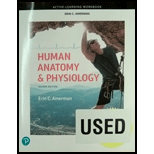
Which of the following are functions of the respiratory system? Circle all that apply.
a. Providing for speech
b. Regulating the autonomic nervous system
c. Maintaining the acid-base balance of the blood
d. Temperature homeostasis
e. Raising the pressure in the abdominopelvic cavity
f. Assisting in blood pressure regulation
Introduction:
The primary function of the respiratory system is a gaseous exchange between the body and the atmosphere. Lungs are the primary organs where this gaseous exchange occurs. This gaseous exchange leads to body tissues getting oxygen for performing metabolic reactions and releasing carbon dioxide as waste.
Answer to Problem 1CYR
Correct answer:
The respiratory system helps in speech, maintaining the acid–base balance of the blood, raising the pressure in the abdominopelvic cavity, and assisting in blood pressure regulation.
Explanation of Solution
Explanation for the correct answer:
Option (a) states that the respiratory system is responsible for producing speech. The larynx, an organ of respiratory system, houses vocal cords that are responsible for the production of sound. Vocal cords or vocal folds are essentially folding of the mucosal lining of the larynx. The core of the vocal cords has vocal ligaments and sound is produced as the air passes through vocal ligaments, which vibrate to produce sound. Hence, option (a) is correct.
Option (c) states that the respiratory system maintains acid–base balance of the blood. An important mechanism to maintain pH of the blood is by chemical-based buffer systems. The most important buffer system of blood is carbonic acid-bicarbonate buffer system. The primary source of carbonic acid and bicarbonate ions in blood is carbon dioxide. When the amount of carbon dioxide in the blood increases, the pH of the blood decreases (acidity increases). Respiratory system, being responsible for exhaling the carbon dioxide, assists in the maintenance of blood pH. Hence, option (c) is correct.
Option (e) states that the respiratory system raises the pressure in the abdominopelvic cavity. The respiratory system deals with breathing that eventually leads to gaseous exchange. Upon holding breath, the diaphragm rises above and the pressure in the abdominopelvic cavity increases. This pressure helps to expel out things in the cavity during urination, defecation, and childbirth. Hence, option (e) is correct.
Option (f) states that the respiratory system assists in blood pressure regulation. Capillaries in the lungs are responsible for the production of an enzyme that synthesizes angiotensin-II, a vasoconstrictor, thereby regulating blood pressure. Hence, option (f) is correct.
Explanation for the incorrect answers:
Option (b) states that the respiratory system controls the autonomous nervous system. However, the autonomous nervous system controls bronchial smooth muscles to regulate respiration. So, it is an incorrect option.
Option (d) states that the respiratory system helps in temperature homeostasis. Temperature homeostasis, in humans, is a function of the brain, skin, and circulatory system. So, it is an incorrect option.
Hence, options (b) and (d) are incorrect.
Therefore, it can be concluded that functions of the respiratory system are to produce speech, maintenance of an acid–base balance of the body, increasing the pressure of the abdominopelvic cavity, and regulation of blood pressure. These functions are performed along with the gaseous exchange that is the main function of the respiratory system.
Want to see more full solutions like this?
Chapter 21 Solutions
Active-learning Workbook For Human Anatomy & Physiology
- Oxygen in air must diffuse across______ to enter the blood. a. pleural sacs b. alveolar sacs c. a moist respiratory surface d. both b and carrow_forwardDuring inhalation, ________. a. the thoracic cavity expands d. the diaphragm relaxes c. atmospheric pressure declines d. the lungs deflatearrow_forwardUnderwater, we humans cant compete with whales and other air-breathing marine mammals, which can stay submerged for extended periods. At the beach one day you meet a surfer who tells you that special training could allow her to swim underwater without breathing for an entire hour. From what you know of respiratory physiology, explain why she is mistaken.arrow_forward
- When you sneeze, abdominal muscles abruptly contract, pushing your diaphragm upward. Given the discussion of the respiratory cycle in Section 10.4, why does this change expel air out your nose?arrow_forwardIn a _______, air flows continually across the respiratory surface. a. fish b. bird c. frog d. mammalarrow_forward
- Basic Clinical Lab Competencies for Respiratory C...NursingISBN:9781285244662Author:WhitePublisher:Cengage
 Concepts of BiologyBiologyISBN:9781938168116Author:Samantha Fowler, Rebecca Roush, James WisePublisher:OpenStax College
Concepts of BiologyBiologyISBN:9781938168116Author:Samantha Fowler, Rebecca Roush, James WisePublisher:OpenStax College Comprehensive Medical Assisting: Administrative a...NursingISBN:9781305964792Author:Wilburta Q. Lindh, Carol D. Tamparo, Barbara M. Dahl, Julie Morris, Cindy CorreaPublisher:Cengage Learning
Comprehensive Medical Assisting: Administrative a...NursingISBN:9781305964792Author:Wilburta Q. Lindh, Carol D. Tamparo, Barbara M. Dahl, Julie Morris, Cindy CorreaPublisher:Cengage Learning  Human Physiology: From Cells to Systems (MindTap ...BiologyISBN:9781285866932Author:Lauralee SherwoodPublisher:Cengage Learning
Human Physiology: From Cells to Systems (MindTap ...BiologyISBN:9781285866932Author:Lauralee SherwoodPublisher:Cengage Learning Biology: The Dynamic Science (MindTap Course List)BiologyISBN:9781305389892Author:Peter J. Russell, Paul E. Hertz, Beverly McMillanPublisher:Cengage Learning
Biology: The Dynamic Science (MindTap Course List)BiologyISBN:9781305389892Author:Peter J. Russell, Paul E. Hertz, Beverly McMillanPublisher:Cengage Learning Cardiopulmonary Anatomy & PhysiologyBiologyISBN:9781337794909Author:Des Jardins, Terry.Publisher:Cengage Learning,
Cardiopulmonary Anatomy & PhysiologyBiologyISBN:9781337794909Author:Des Jardins, Terry.Publisher:Cengage Learning,





